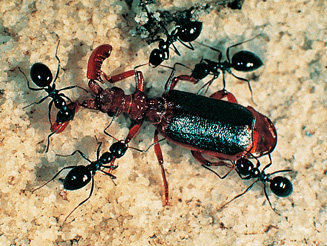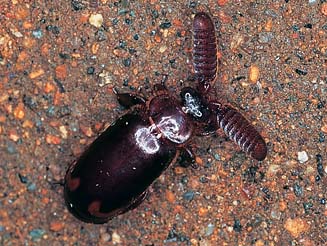Subfamily:
Paussinae (ants' guest beetles, ants' nest beetles)
Life > Eukaryotes > Opisthokonta > Metazoa (animals) > Bilateria > Ecdysozoa > Panarthropoda > Tritocerebra > Arthopoda > Mandibulata > Atelocerata > Panhexapoda > Hexapoda
> Insecta
(insects) > Dicondyla > Pterygota > Metapterygota > Neoptera > Eumetabola >
Holometabola > Coleoptera (beetles)
> Suborder: Adephaga > Family:
Carabidae (ground beetles)
Small to medium sized (4-20mm) beetles,
uniformly dark or pale reddish brown in colour. Their most distinguishing
features are the broad, flattened antennae. All species live in a myrmecophilous
association with ants and these antennae have been reported to be used as
handles by ants to drag the beetle around the nest. The beetles secrete a
volatile substance from subcutaneous glands that is greedily licked up by the
ants, appeasing them and suppressing their usual aggression toward intruders. In
exchange, the beetle and larvae feed on either food provided by the ants or
the larvae feed on the ant brood.
In more specialised species, the
beetle mouthparts are spoon-shaped to readily receive the drops of food
from the ants' mouthparts. The more primitive species rely more on brute
force and defend themselves with a tough integument (covering) and
bombard the attacking ants (or humans) with a gas that contains quinone
secreted in special glands. The gas volatilizes explosively releasing a
puff of vapour.
In some species, the adults only leave
the nest for reproduction and they probably occur above the ground
during the seasonal swarming of ants.
|
 |
 |
|
Lineatopaussus lineatus. This species lives in nests of the ant Lepisiota
capensis. [image
by H. Robertson ©, Iziko]. |
Cerapterus laceratus, Bombadier Ants' Guest Beetle, 13mm, defends itself
with a spray of gas containing quinone, delivered in explosive bursts.
[image by M. Picker & C.
Griffiths ©, from Field Guide to Insects of South Africa,
used with permission]. |
Page by Margie Cochrane |
